
Fuchsia is a genus of flowering plants that consists mostly of shrubs or small trees.
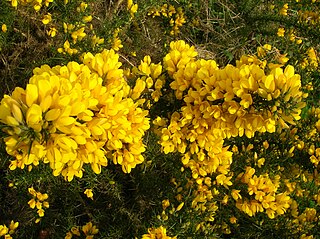
Ulex is a genus of flowering plants in the family Fabaceae. The genus comprises about 20 species of thorny evergreen shrubs in the subfamily Faboideae of the pea family Fabaceae. The species are native to parts of western Europe and northwest Africa, with the majority of species in Iberia.

Magnolia macrophylla, the bigleaf magnolia, is a deciduous magnolia native to the southeastern United States and eastern Mexico. This species boasts the largest simple leaf and single flower of any native plant in North America.

Coprosma robusta, commonly known as karamū, is a flowering plant in the family Rubiaceae that is endemic to New Zealand. It can survive in many climates, but is most commonly found in coastal areas, lowland forests, or shrublands. Karamū can grow to be around 6 meters tall, and grow leaves up to 12 centimeters long. Karamū is used for a variety of purposes in human culture. The fruit that karamū produces can be eaten, and the shoots of karamū are sometimes used for medical purposes.

Echinacea angustifolia, the narrow-leaved purple coneflower or blacksamson echinacea, is a species of flowering plant in the family Asteraceae. It is native to North America, where it is widespread across much of the Great Plains of central Canada and the central United States, with additional populations in surrounding regions.

Persoonia, commonly known as geebungs or snottygobbles, is a genus of about one hundred species of flowering plants in the family Proteaceae. Plants in the genus Persoonia are shrubs or small trees usually with smooth bark, simple leaves and usually yellow flowers arranged along a raceme, each flower with a leaf or scale leaf at the base. The fruit is a drupe.

Allium validum is a species of flowering plant commonly called swamp onion, wild onion, Pacific onion, or Pacific mountain onion. It is native to the Cascade Range, to the Sierra Nevada, the Rocky Mountains, and other high-elevation regions in California, Oregon, Washington, Nevada, Idaho and British Columbia. It is a perennial herb and grows in swampy meadows at medium and high elevations.
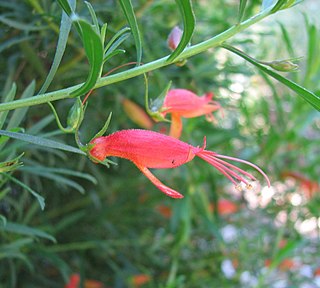
Eremophila decipiens, commonly known as slender fuchsia bush or narrow-leaved fuchsia bush is a flowering plant in the figwort family, Scrophulariaceae and is endemic to an area extending from the south-west of Western Australia to southern parts of South Australia. It is low, sprawling shrub with lance-shaped leaves and red, orange or yellow flowers on a long, S-shaped stalk.

Deutzia gracilis, the slender deutzia or Japanese snow flower, is a species of flowering plant in the hydrangea family Hydrangeaceae, native to Japan.
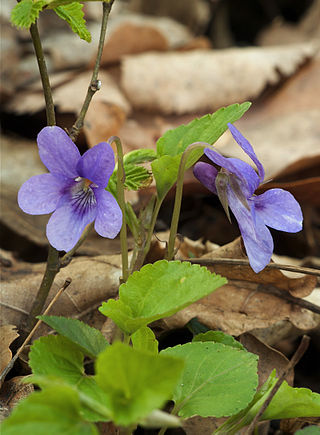
Viola reichenbachiana, also known as the early dog-violet, pale wood violet, slender wood violet, hedge violet, or wood dog violet, is a species of flowering plant in the Viola genus. This species hybridises with Viola riviniana, the common dog-violet, to produce Viola × bavarica. The plant is named after the 19th century botanist Ludwig Reichenbach. It is a rhizomatous herbaceous perennial that is widely known for its purple petals, and it typically resides along road banks or among other rich vegetation, as other wild pansies do. The name dog violet refers to its lack of scent, making it supposedly only fit for dogs.

Senna didymobotrya is a species of flowering plant in the legume family known by the common names African senna, popcorn senna, candelabra tree, and peanut butter cassia. It is native to Africa, where it can be found across the continent in several types of habitats.
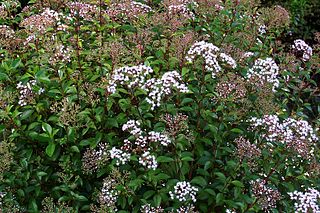
Ageratina ligustrina, the privet-leaved ageratina or privet-leaved snakeroot, is Mesoamerican species of evergreen flowering shrub in the sunflower family. It is widespread across much of Mexico and Central America from Tamaulipas to Costa Rica.

Symphyotrichum lanceolatum is a species of flowering plant in the family Asteraceae native to North America. Common names include panicled aster, lance-leaved aster, and white panicled aster. It is a perennial, herbaceous plant that may reach 1.5 meters tall or more, sometimes approaching 2 m. The lance-shaped leaves are generally hairless but may feel slightly rough to the touch on the top because of tiny bristles. The flowers grow in clusters and branch in panicles. They have 16–50 white ray florets that are up to 14 millimeters long and sometimes tinged pink or purple. The flower centers consist of disk florets that begin as yellow and become purple as they mature.

Aculops fuchsiae, commonly known as fuchsia gall mite, is a species of mite in the family Eriophyidae. It feeds on Fuchsia plants, causing distortion of growing shoots and flowers. It is regarded as a horticultural pest.

Hypericum aegypticum is a species of flowering plant of the St. John's wort family (Hypericaceae) which is native to the Eastern Mediterranean. It was described by Carl Linnaeus in the second volume of his Species Plantarum in 1753, who named it after Egypt despite it not being distributed there. The plant is commonly known as shrubby St. John's wort or Egyptian St. John's wort in English. Like other members of section Adenotrias, it is found among limestone rocks in coastal areas. While it has been evaluated as threatened on the island of Malta, the species has no legal protections.

Helwingia japonica, the Japanese helwingia, is a species of flowering plant the family Helwingiaceae. It is native to South-East Asia.

Moquilea platypus, also known as sun sapote, sansapote, and monkey apple, is a flowering tree in the family Chrysobalanaceae. The specific epithet (platypus) is Neo-Latin for "flat-footed".

Litsea garciae, also known as engkala, engkalak, kangkala, pangalaban, and Borneo avocado, is a flowering tree in the family Lauraceae. It is native to Taiwan, the Philippines, Borneo, the Malay Peninsula, Sumatra, Java, and Sulawesi.
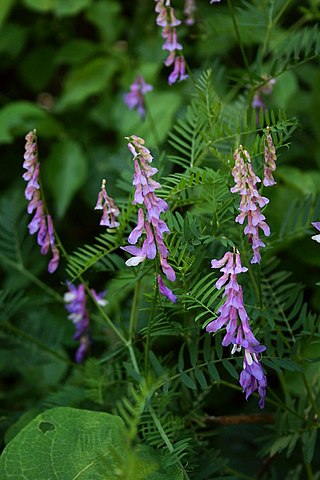
Vicia tenuifolia, the fine-leaved vetch,cow vetch, fodder vetch or bramble vetch, is a herbaceous perennial plant species in the family Fabaceae. This species is widespread in Europe and some parts of both Asia and Africa. In some other areas it occurs as an introduced species. In a few countries this edible vetch is used as food for both humans and farm animals.




























